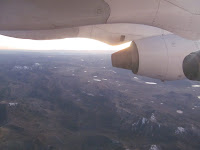Ironically, I spent this Independence Day confined to my bed, as the inevitable has finally occurred: I'm sick. It's 100% my own fault, since I've eaten quite a few dodgy things over the past few days - some traditional sesame ice cream that my professor bought from a street vendor, unpeeled grapes, and perhaps most stupidly, a dish that contained shrimp. Remind me to never eat seafood when I'm 2,746 miles above sea level and 5 hours away from the coast.
Anyway, I'm taking antibiotics, and am feeling much better already. The good news is, since I'm wasn't up for leaving the house/celebrating Independence Day, I finally had time to sit down and write this blog entry!
Last Saturday my group and I took a 5:30am flight out of Lima to Ayacucho, a region in the Andes mountains. As much as I was not enthused about driving to the airport at 3am, I have to admit that watching the sun rise over the mountains was a sight that I will never forget. A picture can't really do it justice but it's worth a shot:
Around 7am, we landed in Ayacucho airport, where we were met by our professors, Ponciano, Lourdes, and Mariano. They whisked us straight to our homestays so we could get some sleep (you may recall from my last entry that we were out salsa dancing until 1am, then got up at 2:30 to go to the airport). My friend Annie and I are living with a wonderful family who own a bakery called La Miel (The Honey) in the Plaza de Armas, where we have class. My friends and I have visited religiously almost every day =)
I have fallen completely in love with Huamanga, the capital city where we're staying. The sky is clear and blue, and we're surrounded on all sides by mountains. When compared to grey, cosmopolitan Lima, Huamanga is much more what you'd imagine a quaint South American city to look like. The buildings are colorful if a little dusty, the streets are full of motos, the adorable 3-wheeled taxis that will take you anywhere for 40 cents, and stray dogs wait at the crosswalk along with all the other pedestrians. Perhaps one of the coolest parts is seeing all the huamanguinas, the old women with traditional braids, hats, and outfits who sell food out of the enormous bundles they carry on their backs.
During a typical day, I have a Political Science class from 10am-1pm, where we're learning about Shining Path, the terrorist organization that operated out of Ayacucho in the 80's and 90's. I'm going to write more about that in another post; it's obviously very affecting to learn about these events in a the city where they happened.
After class and a delicious lunch prepared by my "mom" Charo, I head to my Agency Affiliation. All of us are working with different organizations around Ayacucho, and I've been placed at Casa Hogar Los Cachorros ("The Puppies" Shelter). This is a shelter for children and adolescents who live on the street, particularly those who are recovering from drug addiction. Right now there are 7 boys living there, between the ages of 9 and 17, and for three hours every day I help them with homework, chat with them, and teach theatre games. It's been pretty funny to play Park Bench and Yee-Haw in Spanish - they like them just as much as my American campers do! They've taught me some of their favorite games as well… my shins are covered in bruises from a particularly intense game of fútbol de saltarín, a one-on-one soccer game that uses a trampoline as a field (I was creamed, 50 to 25).
It's a really interesting to work with kids who come from such difficult backgrounds. Most of the kids still have families, but, for some reason or another, chose to leave or were forced out. Their moods are very variable, and I'm still learning how to act with each individual boy so that they'll be receptive. Some days are tough, but others they just act like normal children, joking around and playing. They call me "Sera", which I eventually figured out was not them mistaking me for someone named Sarah, but rather a shortening of profesora.















